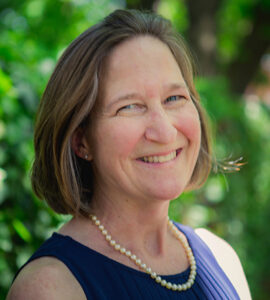 This month’s Insider Interview is with Hilary B. Van Dusen, senior executive editor at Candlewick Press. As of 2021, she’s acquiring titles for MIT Kids and MITeen.
This month’s Insider Interview is with Hilary B. Van Dusen, senior executive editor at Candlewick Press. As of 2021, she’s acquiring titles for MIT Kids and MITeen.
Hilary is the editor of award-winning nonfiction titles including Courage Has No Color: The True Story of the Triple Nickels by Tanya Lee Stone; Jazz Day: The Making of a Famous Photograph by Roxane Orgill, illustrated by Francis Vallejo, The Impossible Rescue: The True Story of an Amazing Arctic Adventure by Martin W. Sandler, Schomburg: The Man Who Built a Library by Carole Boston Weatherford, illustrated by Eric Velasquez, Beyond Magenta: Transgender Teens Speak Out by Susan Kuklin, and Ada and the Galaxies by Alan Lightman and Olga Pastuchiv, illustrated by Susanna Chapman.
What a list, right?
Many of the nonfiction books she acquired explore social issues, science, and/or history, so clearly there’s an interest there which we’ll explore below! Before she took over MIT Kids and MITeen, Hilary also edited middle grade and young adult fiction by such authors as:
Let’s learn more about Hilary right now!
RVC: So, I’m going to start with something most people won’t relate to, but I suspect you will. Despite me putting “Ryan G. Van Cleave” on my published writing, I regularly get called “Mr. Cleave” or “Mr. Van” or something equally mindboggling. Is it fair to assume you experience your own version of this gaffe?
HVD: Ok, not the question I was expecting, but, yes, having a two-word last name is a challenge, not to mention a first name that can easily be misspelled. Luckily for me, though, in my professional life, I am usually referred to by my first name, but when the two-name thing comes up, I get Ms. Dussen–which is not only incorrect, but incorrectly spelled and pronounced!
RVC: On a scale of smiling rainbow unicorns to apocalyptic acid storms, where do these kinds of missteps fall for you?
HVD: There are two smiling rainbow things that used to happen more frequently than it does now. I share a last name with a pretty well-known retired adult editor from Harper. When I go to conferences, I will often be asked if I am his daughter. For the record, I am not! But the idea of a legacy career makes me a bit warm and fuzzy.
I am also asked if I am married to author-illustrator Chris Van Dusen… nope, not that either.
RVC: For the record, I’m also unaffiliated with the jewelry brand Van Cleef & Arpels as well as the actor Lee Van Cleef, as much as I wish it were otherwise. Now that THAT’s out of the way, let’s talk picture books. How has your personal experience with picture books from your childhood informed your approach to editing and selecting new projects?
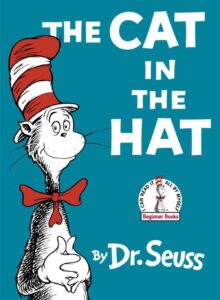 HVD: I am the youngest of 4 kids and had the benefit of a library built by my siblings before me. There were the standards like Winnie the Pooh and Dr. Seuss (I memorized The Cat in the Hat and astonished my babysitters that I could “read”), but I also made frequent trips to the library and was given free reign of the children’s room with the limit of 5 books per visit, according to Mom.
HVD: I am the youngest of 4 kids and had the benefit of a library built by my siblings before me. There were the standards like Winnie the Pooh and Dr. Seuss (I memorized The Cat in the Hat and astonished my babysitters that I could “read”), but I also made frequent trips to the library and was given free reign of the children’s room with the limit of 5 books per visit, according to Mom.
RVC: Oh yeah. I know all about those Mom-created book limits!
HVD: Having that freedom to choose books, the time to ponder my choices, and a home atmosphere that was conducive to spending time (a lot of time) with books, gave me an almost innate understanding of how books can be and should be part of a kids’ life, whether for pleasure or for information. As I grew into my editing career, I concentrated on nonfiction books, because I wanted to publish true stories–incredible stories that don’t need to be made up, stories that hold attention like any piece of fiction.
RVC: How did you land your first editing job?
HVD: I went the internship route, but how I got my first internship is a bit of a story in itself. I was introduced to Anita Silvey, then Editor in Chief of The Horn Book, through the former children’s book editor of The Boston Globe (back when there were regular children’s book reviews in The Globe). She happened to be one of the moms who led a playgroup for my buddies and me when we were preschoolers.
RVC: Lucky you!
HVD: There I was in college, looking for a summer opportunity, and contacting a writer for the The Boston Globe, someone who hadn’t known me since I was 4 years old–a little daunting at the time, but she was incredibly gracious and helpful. Anita Silvey and her staff took me on as a summer intern, which led to a January internship, and a job offer before I graduated from college. Working as an editorial assistant at the Horn Book was like going to grad school. I handled and read every children’s book published for about 2 ½ years before I took an editorial job at Viking.
RVC: What was the first nonfiction picture book you worked on solo?
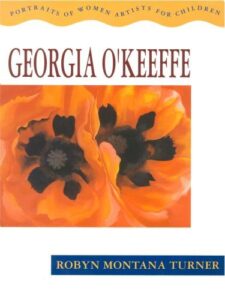 HVD: I worked on my own books when I took a job at Little, Brown in the late 80s, early 90s. I started a picture book series called Portraits of Women Artists by Robyn Montana Turner that featured such greats as Frida Kahlo, Mary Cassatt, Georgia O’Keeffe, and others. Working on those books ignited my fire for editing nonfiction.
HVD: I worked on my own books when I took a job at Little, Brown in the late 80s, early 90s. I started a picture book series called Portraits of Women Artists by Robyn Montana Turner that featured such greats as Frida Kahlo, Mary Cassatt, Georgia O’Keeffe, and others. Working on those books ignited my fire for editing nonfiction.
RVC: What lesson(s) did that book series teach you?
HVD: The Portraits of Women Artists series gave me a crash course in clearing permissions for images and how those permissions influence a book’s budget. That series also showed me how telling a person’s life story through their art can be an inspiring way to talk about a person.
RVC: You’ve worked on a lot of books between then and now. I’m curious about your current thinking as an editor. How do you balance the need for concise and straightforward text with the desire to create engaging and memorable storytelling in picture books? And has that idea changed over the years?
HVD: Good question. Many of the authors I am working with now come from STEAM fields and not necessarily from the children’s book writer community. Many of them are experts in their fields of interest or research, who are committed to reaching children to introduce STEAM concepts. The editing process revolves partly around working with them to think about the audience and how to engage them with the facts with concise language and partly around making sure the narrative arc is successful. As an editor I am committed to planting the seeds of topics that children may not have thought about or been exposed to in a way that will inspire them to want to learn more or dive deeper into a topic.
RVC: You have been especially committed to books about history and culture. Is that a fair statement?
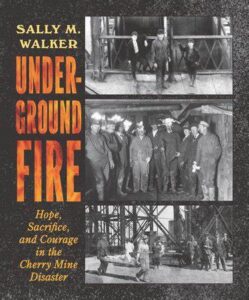 HVD: Yes, that is true. I believe that looking at where we we’ve come from can tell us a lot about where we are today. For instance, I published Underground Fire: Hope, Sacrifice, and Courage in the Cherry Mine Disaster by Sally Walker. That book is centered around a disastrous mine fire, and in the telling covers migrant workers, mine safety reform, and response to tragedy–all topics that are relevant today.
HVD: Yes, that is true. I believe that looking at where we we’ve come from can tell us a lot about where we are today. For instance, I published Underground Fire: Hope, Sacrifice, and Courage in the Cherry Mine Disaster by Sally Walker. That book is centered around a disastrous mine fire, and in the telling covers migrant workers, mine safety reform, and response to tragedy–all topics that are relevant today.
RVC: Let’s talk about a history/culture picture book mentioned in the introduction—Jazz Day: The Making of a Famous Photograph by Roxane Orgill. How did that project come about?
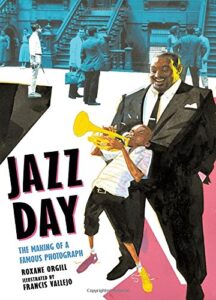 HVD: I had been working with Roxane Orgill on a few books prior to Jazz Day. She ran across the iconic photo of the jazz musicians and researched the photographer and how the photo came about. Turns out it was an incredibly interesting progression of events. She proposed the idea of telling the story of the photograph–an idea that I loved for the reasons stated in my answer to the question above. It was literally a snapshot of a moment in time that said so much about the past, present, and future.
HVD: I had been working with Roxane Orgill on a few books prior to Jazz Day. She ran across the iconic photo of the jazz musicians and researched the photographer and how the photo came about. Turns out it was an incredibly interesting progression of events. She proposed the idea of telling the story of the photograph–an idea that I loved for the reasons stated in my answer to the question above. It was literally a snapshot of a moment in time that said so much about the past, present, and future.
RVC: How does your editorial process differ with poetry (like in this book) instead of a prose manuscript?
HVD: Editing poems that also cumulatively tell a story is different in some ways from editing prose but the same in others. The narrative arc of the whole story has to be taken into consideration and once that is set, the editing is much more at a line and word level. Every word in a poem has a purpose and a beat that needs to be considered. And in the case of Jazz Day, the poems were conveying information about the time and place in history. It takes several passes through the work to address all of those things in an edit. Not to mention conversations with the author about particular words, the placement of the words, and the need (or not) for them.
RVC: At what point did you realize Francis Vallejo was the right illustrator for the job?
HVD: Francis Vallejo was new to children’s books, but an obvious bright star. The then Artistic Director, Chris Paul, showed me his samples, and it took very little convincing to know he was perfect for the job and Roxane Orgill agreed. He had an interest in jazz music, he was willing to work with the photograph and incorporate it into the book. He also did a ton of research and modeling to get everything right–he was incredible to work with.
RVC: People believe you can’t judge a book by its cover, but is that axiom true for picture books? Please explain the importance of a strong and eye-catching cover design for a picture book and how that factors into your editorial decisions.
HVD: The way we create picture books at Candlewick, the cover comes late in the process, after the text is final and the sketches are done. At the point we are designing a cover, many editorial decisions have been made about the book as a whole, but deciding on the right image for the cover is one of the biggest editorial decisions. We want the cover to be representative of what the reader is going to get inside without giving too much away. We want the image to draw in people who glance at it for a few seconds on a shelf. We also want it to be a draw at the size of a thumbnail on a web page. We consider the weight or importance of the bylines in relation to the imagery. If the book is funny, the image needs to convey that, or mindful… you get the idea. But there is also the consideration of trends or standing out from trends. I could write about this for pages, but I think I’ve addressed the basics!
RVC: Let’s help out some aspiring writers. In your experience, what are the most effective ways for picture book authors and illustrators to build a dedicated readership and fan base?
HVD: Beyond writing a book that will attract readers, it’s important for creators to engage with their audience in some way, either through social media and blogging or doing visits to school, festivals, bookstores. The school and library piece cannot be underestimated.
RVC: Totally agree!
HVD: Find ways to engage with teachers and librarians about your work and how it can be used with kids. Publishers do not have a marketing budget to put behind every book, so sometimes it is up to the author to do more legwork in terms of publicity. Lastly, keep writing and publishing, so that you have new titles to talk about and work with. Keep working on your craft so that the next book tops the last.
RVC: Speaking of building a fan base…let’s talk social media. While you have a private Instagram account and you joined Twitter in 2009, you don’t seem especially active online. How purposeful is that choice?
HVD: I am a pretty private person. I believe in a hard line between my professional life and my personal life, which is why I don’t engage much on social media. A public fan base or discussion about my work or my authors on social media is not why I do what I do. I also have published a few books that are often banned, and I do not want to be subjected to the wrath of the banners out there!
RVC: One final question for this part of the interview, Hilary. It’s Brag Time! What’s an upcoming project or two that you’re really excited about?
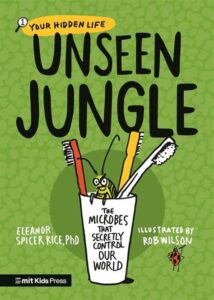 HVD: Just coming out is Unseen Jungle: The Microbes That Secretly Control Our World, the first book in a young middle grade series called Your Hidden Life by Eleanor Spicer Rice and illustrated by Rob Wilson – it’s simultaneously hilarious, gross, informative, and entertaining in a you-just-can’t‑look-away way. (Talk about covers… Unseen Jungle has a cockroach on a toothbrush on the cover!) I’m also excited about a stylish and beautiful picture book biography called Santiago Saw Things Differently by debut author Christine Iverson and illustrated by Luciano Lozano about the father of neuroscience Santiago Cajal, an artist at heart, who, through his art, discovers the truth about neural pathways.
HVD: Just coming out is Unseen Jungle: The Microbes That Secretly Control Our World, the first book in a young middle grade series called Your Hidden Life by Eleanor Spicer Rice and illustrated by Rob Wilson – it’s simultaneously hilarious, gross, informative, and entertaining in a you-just-can’t‑look-away way. (Talk about covers… Unseen Jungle has a cockroach on a toothbrush on the cover!) I’m also excited about a stylish and beautiful picture book biography called Santiago Saw Things Differently by debut author Christine Iverson and illustrated by Luciano Lozano about the father of neuroscience Santiago Cajal, an artist at heart, who, through his art, discovers the truth about neural pathways.
RVC: Alright. With that, it’s time to shift gears from Standard OPB Interview Stuff to Lightning Round OPB Wondrousness. Clearly, speed and succinctness are at a premium, because, well, lightning! Are you ready for the challenge?
HVD: Bring it on, Ryan!
RVC: Who’s your all-time favorite picture book character?
HVD: How can I play favorites???? There are so many I love! Lyle the crocodile, Mercy Watson, the pig, the sheep in Sheep in a Jeep, the Lion in Library Lion, the list goes on (interesting that these are all animals, what does that say about me? Maybe I shouldn’t ask? 😊).
RVC: What book(s) are on your nightstand right now?
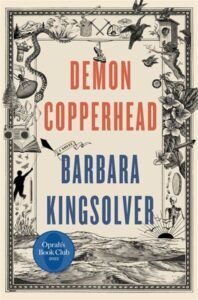 HVD: Demon Copperhead, The Personal Librarian, and The Emperor of All Maladies.
HVD: Demon Copperhead, The Personal Librarian, and The Emperor of All Maladies.
RVC: If someone narrated your life, who would you want to have the job?
HVD: Kate DiCamillo.
RVC: What’s the One That Got Away?
HVD: Chris Van Dusen, when I worked at Little, Brown. Ironically, I ended up working for his publisher in the end.
RVC: What’s the last picture book that actually made you LOL?
HVD: Every one of Jon Klassen’s books.
RVC: Describe the perfect picture book in three words.
HVD: Narrative. Art. Seamless.
RVC: Thanks so much, Hilary!

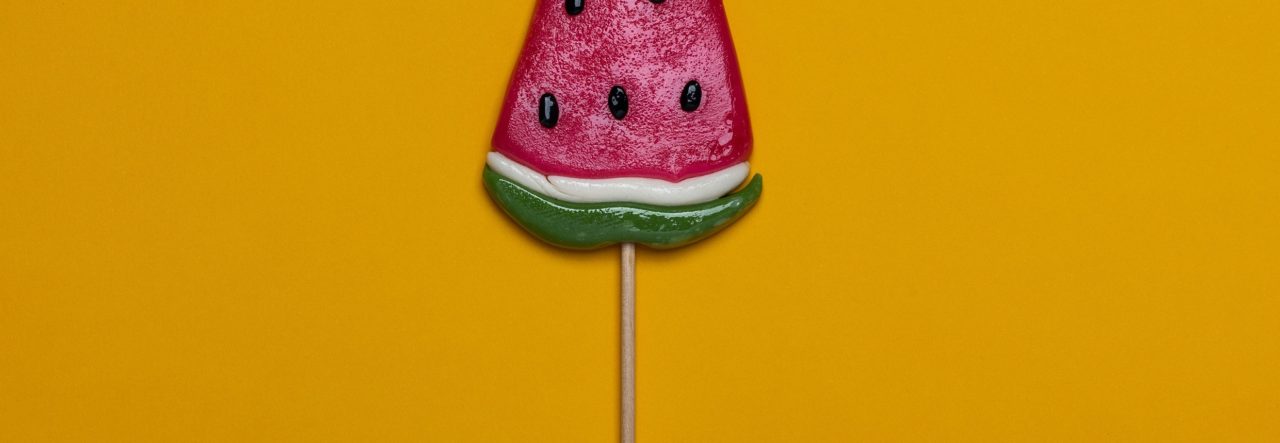
Thank you for the interview and for sharing many amazing Non-fiction authors and titles.